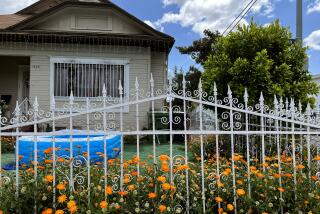Commentary : Builders Can Soothe Uneasy Neighbors : Growth: There may be no way to resolve deep conflicts over new developments in old neighborhoods, but there are some inexpensive ways builders can reduce day-to-day conflicts with residents.
On hot days last fall, I could smell Trevi Villa. That is, I could sniff the musty odor of the site where the Trevi Villa condominiums are going to stand, across the street from me in Hillcrest.
The previous houses on the site were demolished in September, and the three lots were bulldozed into a single field of raw earth, a process that deposited a layer of grime on every surface in my house and sent me fleeing, choking, from my home-office to try to work in coffeehouses.
Last fall’s dust was nothing compared to the hassles this project is about to cause for me and my neighbors, however.
Construction on Trevi Villa started a month or two ago. As I know from the 29-unit and six-unit condos erected on my block during the past two years, living on the same street with a major development project means at least a year of not only dirt, but also noise, parking problems and a powerless feeling that the life of one’s neighborhood is beyond one’s control.
Development in many residential areas of San Diego appears to be inevitable--at least, various slow-growth initiatives I’ve voted for have been defeated.
There is no way to resolve the deepest conflicts involved in development, such as a developer’s desire to do as he likes with property he owns, versus the concern of citizens like me that the character of my neighborhood is being obliterated. However, I think there are some inexpensive ways developers can reduce the day-to-day conflicts between the process of construction and the comfort of nearby residents.
In the hope that developers might take such steps voluntarily, I want to address the following proposals to the development industry directly:
1. Introduce yourself. When you begin construction in a residential area, circulate a flyer to each house and apartment on the block, telling the residents your name and your phone number.
True, you may get some complaints. But, as long as you’re on my block, you’re my neighbor, and I have a right to know who you are.
If the guy next door plays his stereo too loud, I can ask him to turn it down. But in the maze of contractors and subcontractors, it’s often impossible to know who is ultimately responsible for a development project.
After the houses across the street were demolished, all the wood and dirt were pushed into a small dust mountain and left for several days.
It took me half a dozen phone calls to various city offices and subcontractors to track down the owners of the property, the Trevi Group, and let them know the dust was a problem. (They were quite pleasant and the dirt was moved within a few days.)
2. Let people know your plans. Otherwise, the rumor mill will do it, and it will contribute to people’s feelings of powerlessness.
For instance, a few weeks ago a neighbor told me Trevi Villa was going to be 17 stories high, a real disruption on this block of mostly two-story houses; the truth filtered along later that the building would actually be only three stories high.
In the flyer in which you introduce yourself, I suggest you announce what you are planning to build and how long you expect construction to take. This is also a place to address any special concerns a neighborhood may have.
On my block, for instance, many of us compete for street parking with employees of nearby medical offices; I’d appreciate knowing how you plan to provide for parking for Trevi Villa’s occupants.
3. No jackhammers until 8 a.m. It’s my understanding that the city allows construction to begin at 7 a.m. But please! Show some sensitivity to the fact that this is a residential area.
Granted, the most virtuous people on the block are undoubtedly off to work by 7 a.m., but there are such folks as retirees (and self-employed writers) who may choose to get a slower start in the morning.
4. Offer free car washes. It’s not just the dust that’s a problem, it’s the rivers of mud that line the curb during much of a construction project and which end up on everyone’s cars.
How about making arrangements with a local car wash and distributing coupons for free car washes, perhaps once every three months while construction is going on? I suspect the cost would be minimal compared to the good will such an act might generate.
“Stop Destroying Hillcrest!” read a hand-lettered sign I saw during the height of the previous construction on my block. This was on a day when a jackhammer was going nonstop, and I made my own sign: “Stop Destroying This Neighborhood.”
It’s true that, no matter what developers do, I’m not going to like your presence across the street.
But, if you and residents like me must coexist in San Diego, I urge you to consider these few simple actions to ease the hassles for those of us who live in your construction zones.
More to Read
Sign up for Essential California
The most important California stories and recommendations in your inbox every morning.
You may occasionally receive promotional content from the Los Angeles Times.






